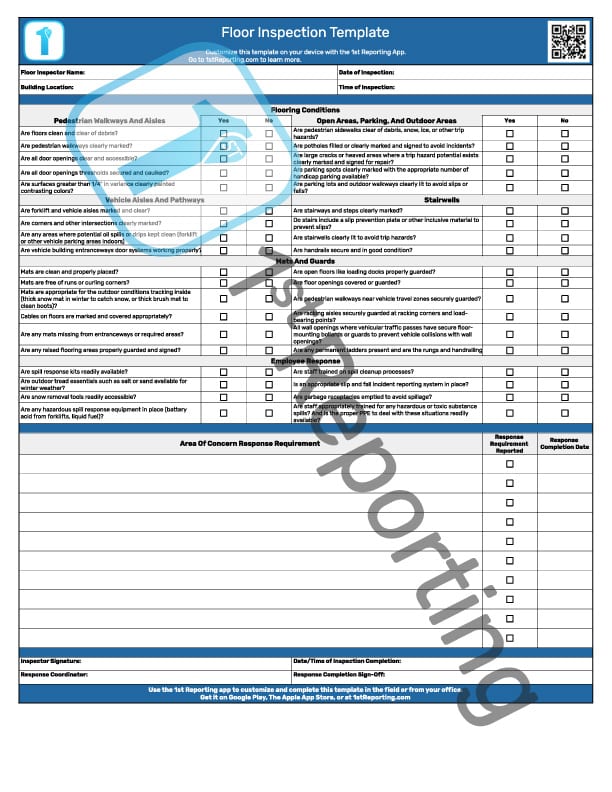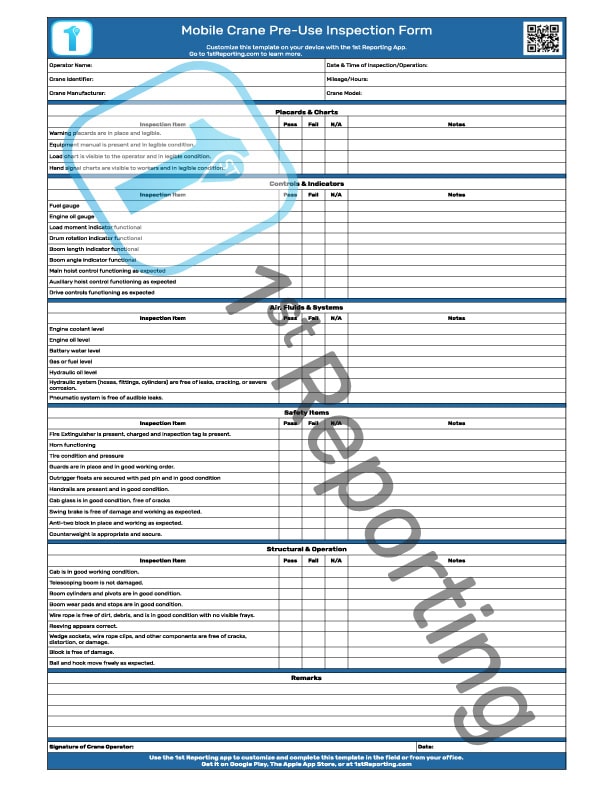Overhead garage door inspection is one of those maintenance tasks we often take for granted. Maintenance personnel is not likely to be too keen on heading up a ladder in a busy shipping area to inspect the doors. So, the overhead garage doors often face neglect until something breaks. The problem is that when something breaks, these doors can fall, creating a potentially life-threatening hazard.
Successful managers utilize an Overhead Garage Door Inspection Checklist for their maintenance team to assess and maintain dangerous overhead sectional doors. Used in parking garages, shipping, and receiving areas, these doors are practical and a source of potential severe hazards.
What do you need to control overhead garage doors’ hazards effectively? Robust training and a system for inspection. Your team must document the assessments for the sake of tracking needed repairs and also to maintain equipment records.
We’ll discuss some of the best practices for managing overhead garage door entry equipment hazards. That way, you can download the template we’ve provided or, better yet, get set up with our app with knowledge of the process required for inspection. You can even use our guide to help train your team. Let’s get into overhead garage door inspection and the checklist you need to complete the task successfully.
Included In The Overhead Garage Door Inspection Checklist
The Overhead Garage Door Inspection Checklist consists of seven sections for your convenience. These sections are detailed below. We recommend having your inspection team read over these points thoroughly to understand how to best approach the inspection process for each.
The sections are segmented to formulate an efficient inspection method, so it’s best to stay in line with our tested procedure. This process comes from over 15 years of industry testing, so we know it works well and will perform for your team.
Administrative Information
Every report, whether for an audit, inspection, or even a checklist for a procedure, needs to have some form of organization for filing and retrieval purposes. The administrative information holds the critical data that includes the facility location, managerial contact, the date of the inspection, and the technician’s name performing the audit.
Pre-Inspection Check
Before any equipment inspection where a team member will work at heights, there are essential safety precautions that require attention. The pre-inspection check items address the significant concerns for typical door inspection scenarios. However, it is vital to note that if the doors are for a parking area such as an underground parking garage, the tenants and team members all must receive 24 hours’ notice at minimum before the door is on scheduled shut down.
Door Interior Inspection Checkpoints
After pre-inspection safety points are addressed, the first inspection of the door itself includes looking at the door sections and hardware. The technician/inspector must verify door operation and balance. The door’s components are all inspected.
The interior inspection will include the shaft assembly. This component assembly of the door is usually located above the door on the wall for full vertical lift doors and sometimes recessed back from the wall, hanging from the ceiling. The ceiling mount will usually occur in low headroom situations, such as parking garage doors. It is critical to inspect the shaft and spring or counterweight assembly due to carrying the door’s weight each cycle.
Door Exterior Inspection Checkpoints
The exterior inspection of the door is usually relatively quick compared to the interior inspection. The exterior of most doors includes checking the weather stripping. For dock-level doors, the exterior inspection becomes more complicated. Usually, it incorporates separate checklists to assess the loading dock and truck restraint where installed. However, for the door portion of this inspection, the technician must also inspect the side seals and shelter if installed to prevent damage to the building or protect it from the elements.
Door Operator Inspection Checkpoints
Most modern facilities utilize power operators to open and close their doors. These operators often use safety devices that your team must regularly check to ensure proper safe functions. Similarly, several operator elements require inspection, such as the brake assembly, bearings, belts, and other moving components.
Post Inspection Check
After inspection of any equipment, especially when working at heights, it is vital to clean up the work area properly. The post-inspection check items address this inspection stage, so you know your team is reminded to keep things clean and lean.
Notes and Sign-Off
The notes and sign-off are last on the list of actionable sections of the Overhead Garage Door Inspection Checklist. The technician or team member will be more inclined to complete the inspection thoroughly, knowing they must sign off on the report’s authenticity.
Best Practices For Using The Overhead Garage Door Inspection Checklist
The checklist works excellent when you have a sectional garage door. Now, keep in mind that the door does not necessarily need to be in a garage. Our template will work for any sectional overhead door, including full vertical and standard lift operations.
We recommend the following procedure for your team’s best use of the template.
- Download the Overhead Garage Door Inspection Checklist
- Print as many copies as you need. One sheet can accommodate five doors. In other words, if your facility were to have 20 shipping/receiving doors and two ground-level drive-in doors, you would need five copies of our template.
- Suppose you’re running a door and dock business. In that case, you understand that you will need many more copies for each client where your team performs overhead door preventive maintenance inspections. If this is the case, or if your company has a lot of your doors to inspect, we recommend something a little more robust than paper forms. Try the 1st Reporting app if you have many doors to maintain.
- Utilize only individuals who have the proper qualifications for the work. There are some non-accredited certifications available for door technicians. However, most companies operate without special trade certifications, except for maybe welding and first aid.

- Most maintenance personnel should have the appropriate training to inspect doors effectively. However, to fully understand doors, one must grasp mechanical and electrical code and possess training in working at heights. Individuals with welding experience are also preferential due to their understanding of the quality of welds – an essential factor in these sorts of inspections. The short of it is to ensure you use only those fully qualified for the inspection.
- If you can choose, go with lift equipment instead of ladders. Ladders are okay in some situations (check with local labor regulations). Still, a technician must have both hands available to perform this inspection properly.
- When completing the inspection checklist, have team members take a photo of the item in question. However, it will not do much good if there are multiple doors. Therefore, have them take a picture of the door number before the images of any issues found with the equipment. This way, any photos following the door number will be identifiable.
- Suppose the number of doors is greater than 10. In that case, we recommend switching from a paper version of the inspection checklist to a digital version. As mentioned earlier, the 1st Reporting app is a perfect tool for this purpose. Team members can use a tablet in a rugged case (with a strap so they don’t drop it) and efficiently complete their inspection notes. All this without fear of damaging or losing paperwork, for that matter, because we all know that paperwork will magically walk away sometimes.
We can prevent lost paperwork (or illegible handwriting) by using a mobile reporting app. With features like offline mode, automated (and customizable) notifications, and intelligent report generation (for trends tracking), the app is lightyears ahead of using old paper checklists. When you have a lot of doors to inspect, try 1st Reporting first.
Digital Reporting Solutions
Looking for a better way to document inspections and safety audits?
1st Reporting was designed with you in mind. We know that time is of the essence when it comes to completing inspections and audits. That’s why we’ve created an app that is easy to use, efficient, and reliable. Your team will be able to complete their documentation quickly and easily – no more wasted time or missed details.
The 1st Reporting App also features automated reports for trend analysis. It means you’ll have all the information you need right at your fingertips without spending hours compiling data yourself. Our geolocation information ensures that your documentation location data is always accurate and up-to-date.
Going paperless can offer several benefits when it comes to incident and inspection reporting. Here are some of the top reasons why you should consider making the switch:
1. Increased Efficiency – With a digital reporting solution, your team will be able to complete their documentation quickly and easily. It means less time wasted on paperwork and more time spent on productive tasks.
2. Improved Accuracy – With features like geolocation and automated report generation, you can be confident that your data is always accurate and up-to-date. No more missed details or inaccurate information!
3. Increased Productivity – Your team will be able to work more efficiently with a digital reporting solution. It means more time spent on productive tasks and less time wasted on paperwork.
4. Reduced Costs – Paperless reporting can help you save money on printing and storage costs. With automated report generation, you’ll save time and money on data entry and analysis.
5. Improved Customer Service – By having all the information you need right at your fingertips, you’ll be able to provide better customer service. With quick and easy access to data, you can resolve issues faster and more efficiently.
6. Enhanced Safety – With a paperless reporting system, you can easily track and monitor safety trends. It allows you to identify potential hazards before they become a problem.
7. Improved Sustainability – Going paperless helps reduce your carbon footprint and protects our environment.
Making the switch to a paperless reporting solution can offer several benefits for your business. Suppose you’re looking for a more efficient, accurate, and productive way to document inspections and safety audits. In that case, 1st Reporting is the perfect solution for you.
Download the 1st Reporting App today and see how much easier your life can be.








